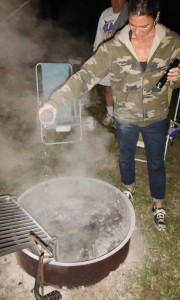When I was about 10 years old, my brother and I were playing with matches and a lighter out in the woods. In a fit of stupidity, we ignited a patch of grass that got out of hand. The fire quickly spread to a nearby hillside, and we did what we thought was best – ran home and hid.
Our uncle who was watching us (ok, he was supposed to be watching us) saw the fire trucks pull up, and jumped in to help stomp out the fire. About two acres of scrub brush went up due to our stupidity, and we got quite the tongue lashing from the fire chief. And my uncle, whose Keds had the bottoms melted off. And when the parents got home, the lashing went from the tongue type to the belt type. We were lucky nobody was hurt, other than our backsides. And those Keds…
…about 8 years later, we lost our house to a fire, along with everything in it…
…locally, back in 1999, we had wildfires spread across part of the town we lived in at the time. It eventually damaged or destroyed over 70 homes and over 5000 acres…
 Needless to say, I KNOW what fire can do if left unchecked.
Needless to say, I KNOW what fire can do if left unchecked.
So when we go camping, I make it a point to be sure that the fire is out before leaving or calling it a night. Even in campfire rings, it gets soaked down with enough water to drown a water buffalo. Call me paranoid.
While I was never a Scout (we lived to far out in the country for a Scout troop!), I did have the Scouting handbook (HAD..I lost it in the house fire!), and read it cover to cover several times. I think they offer very sound fire safety advice:
- I will build a campfire only when necessary and when I have the necessary permits (regulations vary by locality).
- I will minimize campfire impacts or use existing fire lays consistent with the principles of Leave No Trace. I will check to see that all flammable material is cleared at least 5 feet in all directions from fire (total 10 feet).
- I will safely use and store fire-starting materials.
- I will see that fire is attended to at all times.
- I will make sure that water and/or shovel is readily available. I will promptly report any wildfire to the proper authorities.
- I will use the cold-out test to make sure the fire is cold out and will make sure the fire lay is cleaned before I leave it.
- I follow the Outdoor Code and the principles of Leave No Trace.
This leads me to the point of this long-winded story, the extinguishing a fire and using the “Cold Out Test”.
In order to properly (per the Scout Handbook” put out a campfire, you need to
 Step 1. Allow the wood to burn completely to ash, if possible
Step 1. Allow the wood to burn completely to ash, if possible
Step 2. Pour water over the coals until hissing sound stops.
Step 3. Stir the coals thoroughly.
Step 4. Add more water evenly over the coals.
When you think you have it out, use your hand to see that there are no hot spots left, making sure everything is wet and cold to the touch (“cold out”).
I’ve had other adults make fun of me when I do this, but I’d rather be safe than sorry…..
And they wouldn’t laugh if they’d seen those melted Keds!
Peace,
db
Great tip! One all kids should be taught in elementary school! Thanks for the opportunity to watch your brother laugh while reading this one. <3
<3
We were NOT laughing at the time, I assure you!
Thanks for this great tip DB. I will be sharing this with my 11 Y/O who this past summer, i trusted him with his very own fire striker. The trust was premature as he was later found trying to ignite new green hay bales still sitting out in the back forty. There was a bit of tongue lashing and severe warnings about consequences of his actions.
Kids…..
Thanks again for an always timely tip.
Tin
I don’t trust many kids…I used to be one!
(And my wife would say I still am!)
What is funny is that as long as I can recall, I’ve been that way about campfires….but didn’t actually remember setting the woods on fire until I sat down to write the article…selective memory, I guess…good news is that the lesson is deeply ingrained now